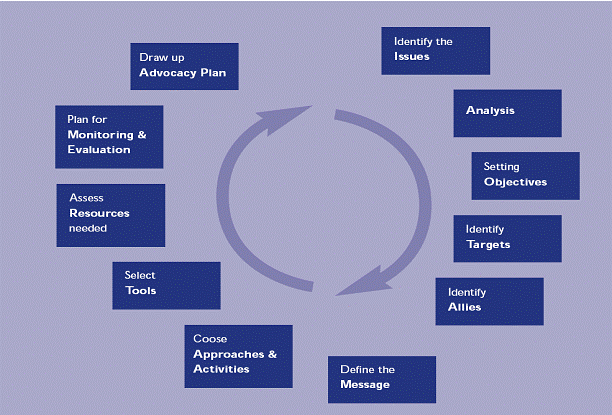High Level Engagement for Integrated Water Resource Management

Figure 1.Advocacy Source book. A Guide to Advocacy for WSSCC co-ordinators on the WASH campaign
High level engagement or high level advocacy means to appeal to policy makers, to influence their decisions through targeted actions. These actions can be achieved by using key communications tools such as putting out influential advertisements, news briefs and targeted promotions. In order to successfully engage in high level engagement, there is a need to identify what the issues are, who needs to be targeted by your campaign, who can help, what is planned to be achieved by the advocacy and the steps needed to do this. High level engagement is essential when trying to ensure that the work you are trying to do or the objectives you are trying to achieve with your program is properly legislated and enters the policy domain. We have selected a few key documents to help the users of this toolkit engage in high level engagement.
How to Create AwarenessCreating awareness on Integrated Water Resource Management is necessary in order to raise the public and political profile of IWRM. In order to do this the right environment must be created where people and politicians become familiar with the concept of IWRM, are aware that it is quite feasible and is essential if we want to really tackle our water problems. This can be only done by using the right communications tools (more information on this is available in the “Engaging Media for IWRM” toolkit). The resources here will help you gain a better understanding of high level engagement, how you can draw up an advocacy plan and create awareness on a topic of your choice.
1) Advocacy for Water, Environmental Sanitation & Hygiene. – IRC
2) Advocacy Source book. A Guide to Advocacy for WSSCC co-ordinators on the WASH campaign
3) Effective Policy Advocacy: An RNRRS Synthesis.
ExamplesThe following resources are examples of how high level engagement can be put into play. They illustrate that this type of material does not have a standard but can come in many types and formats, but they all try to engage policy makers and influence their decisions. More case studies and examples can be found in the communications and gender toolkits.
1) Letter to My Minister (GWP)
2) Effective Water Governance- Learning from the dialogues (GWP)
3) Change- Adaptation of water resources management to climate change.
High level engagement or high level advocacy means to appeal to policy makers, to influence their decisions through targeted actions. These actions can be achieved by using key communications tools such as putting out influential advertisements, news briefs and targeted promotions. In order to successfully engage in high level engagement, there is a need to identify what the issues are, who needs to be targeted by your campaign, who can help, what is planned to be achieved by the advocacy and the steps needed to do this. High level engagement is essential when trying to ensure that the work you are trying to do or the objectives you are trying to achieve with your program is properly legislated and enters the policy domain. We have selected a few key documents to help the users of this toolkit engage in high level engagement.
How to Create AwarenessCreating awareness on Integrated Water Resource Management is necessary in order to raise the public and political profile of IWRM. In order to do this the right environment must be created where people and politicians become familiar with the concept of IWRM, are aware that it is quite feasible and is essential if we want to really tackle our water problems. This can be only done by using the right communications tools (more information on this is available in the “Engaging Media for IWRM” toolkit). The resources here will help you gain a better understanding of high level engagement, how you can draw up an advocacy plan and create awareness on a topic of your choice.
1) Advocacy for Water, Environmental Sanitation & Hygiene. – IRC
2) Advocacy Source book. A Guide to Advocacy for WSSCC co-ordinators on the WASH campaign
3) Effective Policy Advocacy: An RNRRS Synthesis.
ExamplesThe following resources are examples of how high level engagement can be put into play. They illustrate that this type of material does not have a standard but can come in many types and formats, but they all try to engage policy makers and influence their decisions. More case studies and examples can be found in the communications and gender toolkits.
1) Letter to My Minister (GWP)
2) Effective Water Governance- Learning from the dialogues (GWP)
3) Change- Adaptation of water resources management to climate change.

















